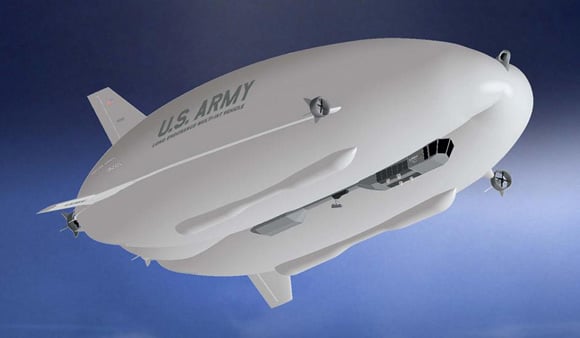Original URL: https://www.theregister.com/2010/12/23/lemv_cargo_potential/
Massive new US spy airship 'could be used to carry big cargoes'
Mighty Brit-designed vessel could swap height for grunt
Posted in Science, 23rd December 2010 15:23 GMT
The huge LEMV* surveillance airships now being built by British designers for the US Army may be able to carry substantial cargoes as an alternative to sky-spy equipment, according to reports.

Might not just be a spy-eye but a sky truck, too.
Aviation Week, in an update on the LEMV programme, quotes project chief Alan Metzger as saying that the vast airships are designed so that "mission and fuel modules can be removed and replaced with cargo modules".
In their standard configuration, the LEMV ships ("up to three" were ordered in June for $517m) would carry a 2,500lb payload of sensors and communications equipment on unmanned missions lasting up to 21 days. The 300-foot-long ships are "optionally manned" – they will be piloted where this is a legal requirement, as for example when transiting civil-controlled airspace, but for long surveillance missions they would normally be controlled from a ground station.
Swapping out the mission equipment would permit a LEMV to carry just 2,500lb of cargo to start with – not all that much. But three-week missions as standard indicates that the ships could spare a lot of fuel space for shorter flights of just a few days or less, suggesting that larger cargoes could be carried.
Then, an airship's lifting capacity decreases sharply as its maximum operating altitude increases. An airship's ceiling is set by its "pressure height" – the altitude at which its helium lifting gas has expanded to fill all available space inside the envelope. In order to have a higher pressure height, less gas must be put into the ship to start with, meaning that it will lift less stuff off the ground.
Then there's the matter of ballast
Things aren't quite this simple with the LEMV, which gets extra lift from swivelling propulsion for takeoff and from air flowing over its surface while underway – it is a "hybrid" airship, not a true lighter-than-air vehicle.
Nonetheless, if its owners were happy to accept a lower ceiling than 20,000 feet, it would be possible to put more helium into the ship and so to carry more cargo. All in all, with fuel and sensors removed and extra gas added, the LEMV might be able to carry quite an impressive amount of stuff.
Needless to say, in Afghanistan it might not be that advisable to fly low – an LEMV would be a big target, and an enemy on the ground there is usually at quite high altitude himself. But an LEMV in unmanned mode would at least not be putting any aircrew at risk: and perhaps the added-gas option could be forgone for smaller cargoes.
One major snag would be that of offloading at any location unable to supply water or other suitable ballast to replace the cargo. A lighter-than-air ship unloading has to take on ballast weighing the same as the cargo lost, or vent off expensive helium: if she doesn't, she'll become uncontrollably buoyant, surge up through pressure height and lose gas anyway through automatic safety valves.
Things aren't quite as bad for the LEMV, which would set down in a heavy condition supported by engine thrust as well as gas. But offloading a big cargo would still probably call for taking on a lot of ballast, which might be hard to arrange at many Afghan bases.
All in all, the US Army probably won't be using its new airships for cargo operations – not in Afghanistan, anyway. But it's still an intriguing option, and the news that potentially-useful cargo ships will soon be flying is sure to delight airship fans. Reportedly, various branches of the US military have made enquiries about the LEMV's cargo-carrying potential.
Av Week, quoting Metzger, says that first manned flight is set for July next year. Unmanned long-endurance trials will follow, and the first ship is to deploy to Afghanistan at the end of next year. If the Army are pleased with it, more may be built. ®
*Long Endurance Multi-Intelligence Vehicle